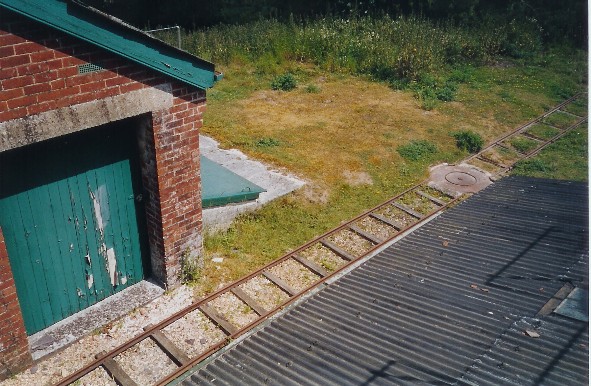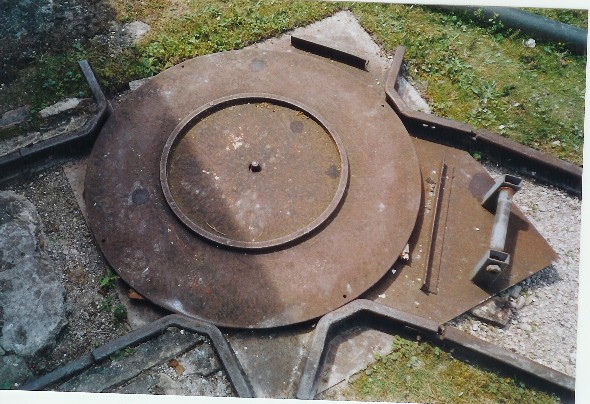|
|
|
| The Railway - History | |
|
The Narrowgauge Railway at Twyford 1898-1921 The equipment for the pumping and softening of water was served in various ways. For instance, a railway was constructed to convey coal and chalk within the works. Coal was delivered by horse and cart from Shawford Station. This was usually obtained from South Wales, and any decrease in coal consumption arising from increased efficiency was more than offset by the increased duration of pumping. Chalk was extracted from the pit adjoining the works. Baldwin Latham. The Consulting Engineer drew attention to the need for a railway in 1902. On the level, manual power would be used, but the incline, leading from the floor of the chalk pit up to the lime kiln was to be rope worked, the power being provided by a three-throw hydraulic engine. Three suppliers were involved. James Simpson provided the hydraulic engine. Three hundred feet of steel wire rope, to haul the wagons up and down the incline, was supplied by Messrs. J & E Wright of Birmingham. The two-foot gauge track, with turnout and turntables, together with two tip wagons or skips, came from Robert Hudson of Leeds. The rails and other plant for the railway had arrived from Shawford Station by April 1903. It was used for moving coal into the boiler house immediately, but the rope-worked incline was delayed until November, when the hydraulic engine was completed. There were no significant changes in the railway system until first, the end of lime burning, and then the disuse of coal-fired boilers, led to its abandonment. Associated with the use of coal was the measurement of its consumption by means of weighing. When William Matthews took over as Consulting Engineer, he recommended an improvement on checking the coal fed to the boilers by the installation of a weighbridge inside the gate, which would measure quantities of coal entering the works, both for the boilers and the kilns. Contracts were awarded in 1908 to Messrs. F Osman for constructing the necessary brick pit and adjoining cabin, and to Messrs. Pooley for a weighbridge to measure weights up to five tons (this was sufficient for the normal horse and cart deliveries). The weighbridge was installed in November 1908, and continued in use throughout the period of coal firing. |
|
 |
1922-1945
There were no great changes in the railway system. In 1939, with the cessation of lime burning, only the section for conveying coal to the boiler house remained in use. The track ran over the weighbridge inside the boiler house, which continued to measure the amount of coal used by the boilers. Stocktaking of fuel was carried out each Saturday, the weight of coal arriving on site being measured by the weighbridge installed in 1908. The fuel oil in the tanks was measured by gauges. Apart from labour, the main running cost of pumping water at Twyford depended on the fuel bill. In this respect, Twyford was dearer than Otterbourne, which had the advantage of being adjacent to the main line railway, with a private siding for the delivery of coal. For instance, prices quoted by Messrs Stephenson Clarke for Wemyss Cobbles in 1932 were as follows:- Delivered at Otterboume £1 3s 1Id (app. £1 2Op) per ton, at Twyford £1 6s 8d (app. £1 33p) per ton, and at Timsbury £1 7s 2d (app. £1 per ton. This variation in the price of coal was one of the reasons that, in the mid-thirties, when new pumps were being installed at all three stations, Otterbourne was equipped with steam turbines while Timsbury and Twyford received diesel engines. |
|
1946-1974 The section of the railway, including the rope-worked railway incline which served the lime kilns, was disused during the war. When softening was resumed in 1946, the lime was delivered direct to the lime store by lorry from Derbyshire. The lower part of the incline had been cut away to provide space for a mess hut, but the rails on the upper part of the incline were left intact. On the section serving the boiler house, the turntable was taken up, together with some of the track, but other parts were preserved under new surfaces. The hydraulic motor which operated the incline was removed.
Recent David Molyneux had been restoring our two weighing machines, and Messrs Avery were good enough to check them for us. For the railway, the Army had donated unwanted rail from |
 |